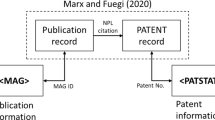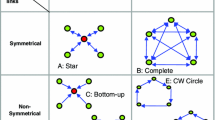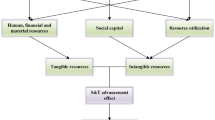Abstract
This article depicts some features of the geography of science and technology outputs in the EU, with a particular attention to regional “co-location” of these two pillars of the “knowledge-based society”. Economists have, for a decade, paid great attention to local “spillovers” stating that industrial firms often draw advantages from the presence of nearby academic centres. The presence in the same areas of strong academic and technological resources is both a condition and a result of science-technology interactions. Concentrating on publications and patents as proxies of the science and technology level in regions, we built a typology of regions according to their commitment to the two knowledge-base activities and then analysed the co-locations of science and technology from several points of view. A fine-grain lattice, mainly based on standard Nuts3 level, was used. Co-location, at the EU level, is not a general rule. A strong potential for spillover/ interaction does exist in the top-class regions which concentrate a high proportion of European S and T output. But for regions with a small/medium level of S&T activity, a divergence of orientations appears between a science-oriented family and a technology-oriented family, indicating an imbalance between local S and T resources. If we look at the S-oriented regions, whilst controlling for underlying factors, such as population and regional economic product, a significant geographic linkage between T and S appears. This suggests a trajectory of science-based technological development. A careful examination of S&T thematic alignments and specialisation is necessary to develop the hypothesis that fostering academic resources could increase the technological power along a growth path.
Similar content being viewed by others
References
ACS Z. J., AUDRETSCH D. B., FELDMAN M. P. (1994), R&D spillovers and recipient firm size, The Review of Economics and Statistics, 76 (2): 336-340.
ANSELIN L., VARGA A., ACS Z. (1997), Local geographic spillovers between university research and high technology innovations, Journal of Urban Economics, 42: 442-448.
AMABLE B., BARRE R., BOYER R. (1997), Les Systèmes d'innovation à l'ère de la globalisation, Economica, Paris.
AUDRETSCH D. B., FELDMAN M. P. (1996), R&D spillovers and the geography of innovation and production, The American Economic Review, 86 (3): 630-640.
BARRE R., ESTERLE L. (Eds) (2002), Science & Technologie, Indicateurs 2002, Economica, Paris.
BARRE R., LAVILLE F., ZITT M. (1997), The dynamics of S&T activities in the EU regions, In: Strategic Analysis for S&T Policy Intelligence, EU (TSER) report.
BARRE R., PAILLARD S., CADIOU Y., PETIT S. (2000), Typology and dynamics of the innovation systems, OST, CDIS-TSER WP2, In: Comparative Dynamics of Innovation Systems (CDIS), project 1077, EU-TSER-2 Programme, OST, coord.
CLIFF A. D., ORD J. K. (1981), Spatial Processes, Models and Applications, Pion, London.
COOKE P. (1998), Introduction. Origins of the concept, In: BRACZYK H. J., COOKE P., HEIDENREICH M. (Eds), Regional Innovation Systems: the Role of Governances in a Globalized World, UCL Press, London.
DASGUPTA P., DAVID P. A. (1994), Toward a new economics of science, Research Policy, 23: 487-521.
ELQUIST C. (1997), Systems of Innovation, Technologies, Institutions and Organisations, Pinter, London.
FELDMAN M. P., FLORIDA R. (1994), The geographic sources of innovation: Technological infrastructure and product innovation in the United States, Annals of the Association of American Geographers, 84 (2): 210-229.
FREEMAN C. (1987), Technology Policy and Economic Performance: Lessons from Japan, Pinter, London.
GIBBONS M., LIMOGES C., NOWOTNY H., SCHWARTZMAN S., SCOTT P., TROW M. (1994), The New Production of Knowledge, SAGE, London.
GRUPP H., SCHMOCH U. (1999), Patent statistics as economic indicators, Research Policy 28 (4): 377-396.
JAFFE A. B. (1989), Real effects of academic research, American Economic Review, 79 (5): 957-970.
JAFFE A. B., TRAJTENBERG M., HENDERSON R. (1993), Geographic localisation of knowledge: Spillovers as evidenced by patent citations, The Quarterly Journal of Economics, 63 (3): 577-598.
LUNDVALL B. A. (Ed.) (1992), National Systems of Innovation. Towards a Theory of Innovation and Interactive Learning, Pinter Publishers, London.
MADDALA G. S. (1992), Introduction to Econometrics, Prentice-Hall, USA.
NARIN F., HAMILTON K. S., OLIVASTRO D. (1997), The increasing linkage between U.S. technology and public research, Research Policy, 26 (3): 317-330.
NELSON, R. R. (1993), National Innovation Systems. A Comparative Analysis, New York, Oxford University Press.
NIOSI J., BELLON B. (1994), The global interdependence of national innovations systems, Technology in Society, 16: 173-197.
PAVITT K. (1985), Patent statistics as indicators of inventive activities: Possibilities and problems, Scientometrics, 7: 77-99.
SCHMOOKLER J. (1966), Invention and Economic Growth, Harvard University Press.
ZITT M., BARRE R., SIGOGNEAU A., LAVILLE F. (1999), Territorial concentration and evolution of science and technology activities in the European Union: a descriptive analysis, Research Policy, 28 (5): 545-562.
ZITT M., RAMANANA S. (2000), The dynamics of S&T activities in the EU regions, part C, In: Comparative Dynamics of Innovation Systems (CDIS), project 1077, EU-TSER-2 Programme, OST, coord.
ZITT M., RAMANANA S., BASSECOULARD E. (2003), Correcting glasses help fair comparisons in international science landscape: country indicators as a function of ISI database delineation, forthcoming in Scientometrics, 56 (2) 259-282.
ZUCKER L., DARBY M., ARMSTRONG J. (1994), Intellectual Capital and the Firm: The Technology of Geographically Localized Knowledge Spillovers, NBER working paper series 4946, NBER, Cambridge.
Author information
Authors and Affiliations
Rights and permissions
About this article
Cite this article
Zitt, M., Ramanana-Rahary, S., Bassecoulard, E. et al. Potential science-technology spillovers in regions: An insight on geographic co-location of knowledge activities in the EU. Scientometrics 57, 295–320 (2003). https://doi.org/10.1023/A:1024145920210
Issue Date:
DOI: https://doi.org/10.1023/A:1024145920210




